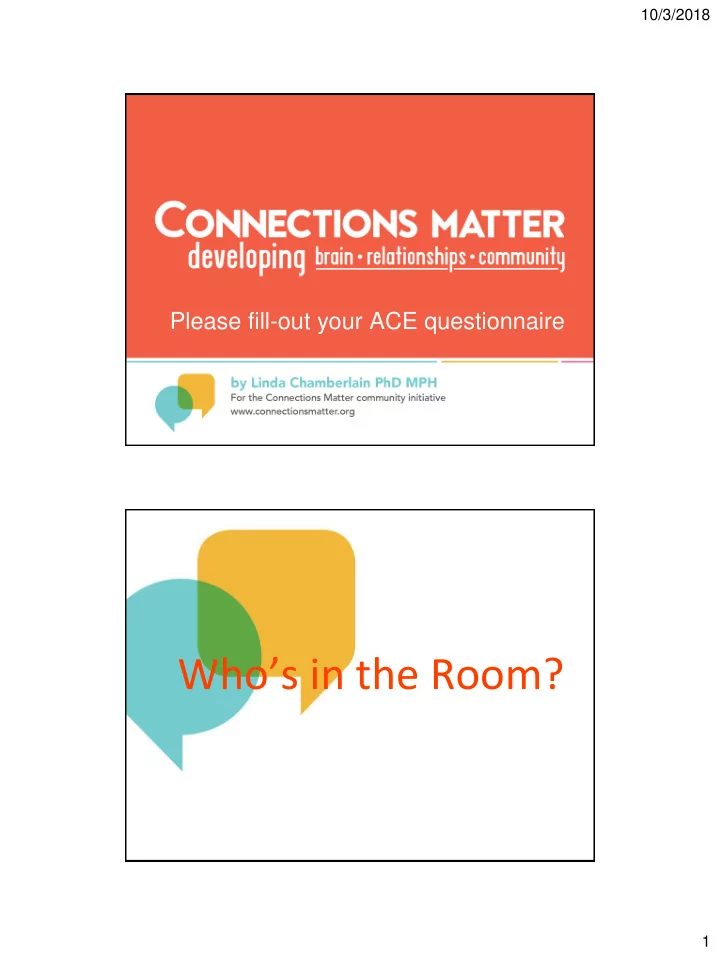

10/3/2018 Please fill-out your ACE questionnaire Who’s in the Room? 1
10/3/2018 Adverse Childhood Experiences ACES What are ACES? The original ACE Study was done in a population of 70% Caucasian and 70% college-educated. This is NOT just a poverty issue. 2
10/3/2018 Think about your personal ACE Score… 1. How does it impact your work with kids? 2. How does your ACE score impact your relationships outside of work? Where do Iowa adults with ACEs live now? *Map does not reflect where trauma occurred, but rather where adults with four or more ACEs currently live. From the Central Iowa ACEs Coalition. Beyond ACEs: Building Hope & Resiliency in Iowa. 2016. 3
10/3/2018 4
10/3/2018 Write down 5 students who you work with or will work with who you are concerned about. Think about a colleague who may be having a tough time. Ever wonder what more you could do to help? Science is showing us that the little things we do to connect make a big difference! 5
10/3/2018 Building Better Brains 6
10/3/2018 Fight, Flight, Freeze 7
10/3/2018 Survival Mode • Universally, according to our biological makeup, we choose FLIGHT first. • Our backup plan is typically FIGHT. 8
10/3/2018 Fight, Flight, Freeze in the classroom Fostering Resilient Learners- Strategies for Creating a Trauma- Sensitive Classroom Now, think about student attendance... Thinking in terms of FIGHT, FLIGHT, FREEZE, could this change your thinking? 9
10/3/2018 We need to feel safe to think and learn, but stress can push us DOWNSTAIRS in our brain… Our brains have the capacity to make trillions of connections 10
10/3/2018 Teaching Self-Regulation and Self- Evaluation Self-Regulation: The ability to monitor and control our own behavior, emotions, or thoughts. 11
10/3/2018 1. Model Self-Regulation Tell students how to name their feelings by telling them how you feel and what you will do about it. “I am feeling angry right now so I am going to walk away and we’ll talk about this later. “I’m feeling frustrated so I’m going to take a deep breath.” 12
10/3/2018 Release 13
10/3/2018 2. Explicitly Teach Use morning meetings or circle time to have students come up with ways to self- regulate. Teach, Model, Practice 14
10/3/2018 15
10/3/2018 In order to change negative behavior to positive, the positive experience must be repeated 40 to 100 times with consistency and predictability 3. Positively Reinforce (Specific Positive Feedback) : “Tommy, I can see you used the strategy of box breathing when you were getting frustrated. You are learning to manage your feelings.” 4. Set Goals: Meet with students one-on-one to set goals for your classrooms. 5. Use Mindfulness Exercises as a class (Box Breathing) 16
10/3/2018 Box Breathing Just Breathe 17
10/3/2018 How do we combat Toxic Stress and ACES? 1. Sleep 2. Mental Health 3. Exercise 4. Nutrition 5. Meditation/Mindfulness 6. Healthy Relationships 18
10/3/2018 Everyday Leadership Mindful minute 19
10/3/2018 “What we do for ourselves dies with us. What we do for others and the world remains and is immortal." -Albert Pine Make Connections 20
Recommend
More recommend